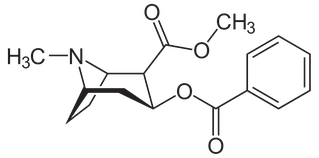Cocaine
Name:
Cocaine, coke, flake, snow, blow
Effects:
Euphoria, alertness, increased confidence, energetic, sexual arrousal (low doses)
Side effects:
Increased heart rate, high blood pressure, dilated pupils, nausea, hyperstimulation, violent behavior, hallucinations (visual and/or tactile), depression, drug craving, panic attack and psychosis, convulsions.
Mechanism of action:
Blockade of dopamine active transporter (DAT) protein resulting in accumulation of dopamine in the synaptic cleft. Antagonizes ligand-gated ion channel 5-HT3 receptors.
Inhibits re-uptake of dopamine, serotonin, and norepinephrine.
Cocaine blocks sodium channels interfering with propagation of action potentials, acting as a local anaesthetic.
Predominantly plasma hydrolysis by plasma cholinesterase. Minimal hepatic metabolism. Half-life is 30 to 90 minutes. When consumed with alcohol forms cocaethylene, a metabolite with an even higher cardiovascular toxicity than cocaine by itself.
The effects of cocaine start within seconds to minutes after injecting or insufflating and last for 5 to 90 minutes.
Cocaine is highly addictive, effecting reward pathways in the brain. Use leads to over-expression of DeltaFosB protein in the nucleus accumbens, resulting in altered transcriptional regulation in neurons within the nucleus accumbens. Elevated DeltaFosB increases brain-derived neurotropic factor, increasing dendrites involved in the prefrontal cortex.


Substance and dosage:
powder (salt (HCI, SO4, NO3) or base). Insufflated, smoked, injected or based. Typical user dosage 35mg (key) to 100mg (rail), up to 250-500mg per day. Higher doses in frequent users occur.
Overdosage:
Hypertensive emergency, extreme hyperthermia, rhabdomyolysis leading to renal failure, arrhythmia, psychosis, seizures, stroke, coma. Lethal cases have been described in first time users.
Increased risk of overdose when combined with other substances:
Alcohol => forms metabolite cocaethylene with higher risk of cardiovascular complications.
Heroin => known as 'speedballing', where the effects of both drugs may cancel out overdose symptoms until the effect of one of the drugs wears off.
Treatment is best supportive care and treatment of symptoms. Benzodiazepines may be used to treat seizures.
Patients whose hypertension does not respond to adequate sedation should be considered for intravenous nitroprusside infusion.
There is no evidence of any clinically useful method of enhancing cocaine elimination.
